|
| |
Links: Scroll
down for the more maps for Meadow
Claws --
Conomo
-- Duke --
Goody --
Homer --
L.R.
-- Mittark --
Penelope
Birds
of Prey page -- Osprey
main page --
Migration08 -- Migration
page -- Home
Page
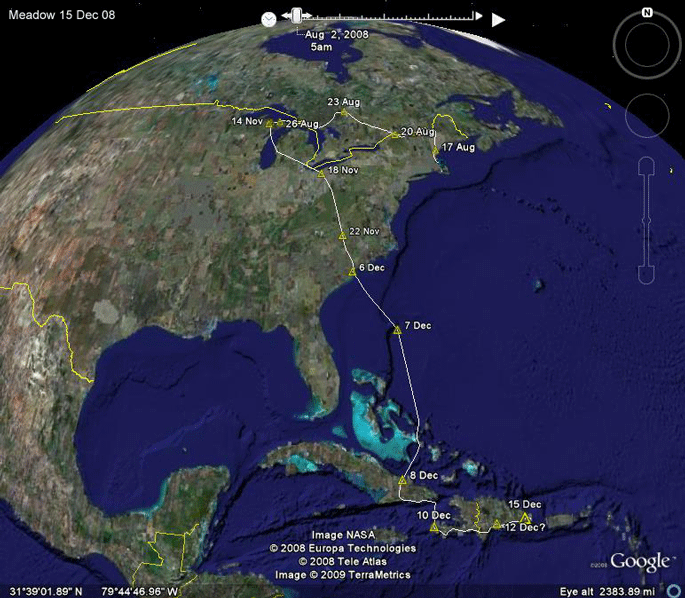 |
Travels so far
17 Aug 08 - 7
Jan 09.
Meadow left the Vineyard
on August 17th, 15 days after we tagged him.
His travels over the next two weeks were off-the-charts
weird. Meadow flew due north for two days, passed into Canada, and was
within 250 mi. of Hudson Bay on the 23rd.
He wound up on the southern shore of Lake Superior on
the 27th, having, in 11 days, flown 1314 mi. (2115 km) in the wrong direction.
Pretty clear evidence that this is a male--a female would have stopped
to ask for directions. (Actually, our supposition that the bird is a
male is based on size.)
At this point, Meadow began acting like a bird
on its wintering grounds. The thing is, it's not supposed to be winter on the
wintering grounds. The wintering grounds are where you go to get away
from winter.
On November 15th, presumably spurred by sub-freezing nights and snow on the
ground he finally started migrating in the right direction, arriving on
the SC coast 3 weeks later (with a stop in Greensboro,
NC, where he kindly posed for photos).
Probably because I had predicted he would stay on the
coast, he then took off into the wild blue yonder of the Atlantic, and a
week later was in the Dominican Republic.
For about three weeks Meadow wandered around an area
west of the town of Higuey. Unfortunately, he discovered a pond at a
farm where the owners did not want to share their fish. His last signal
was from this pond, where he was apparently shot--a very sad ending to a
most fascinating migration. If there was ever a bird that we wanted to
see return and migrate a second time--what route would he take?--this
was that bird.
Scroll down for details-. |
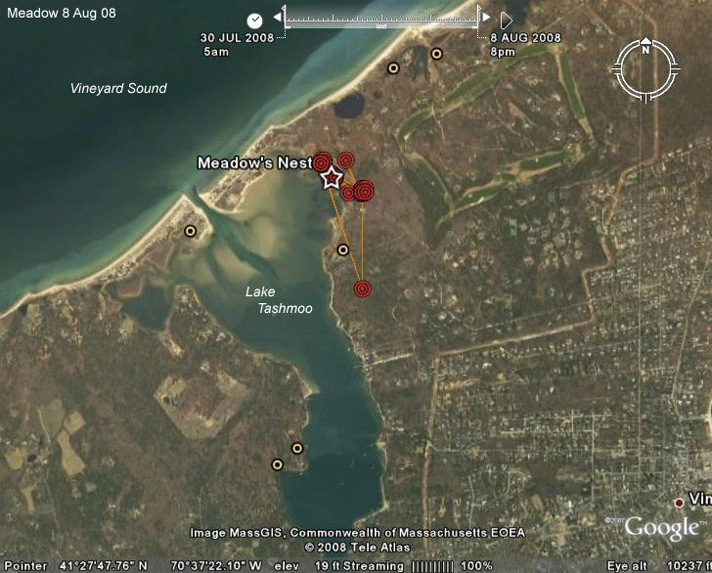 |
8
August 2008.
Meadow has been staying
pretty close to the nest on Tashmoo. The little yellow donuts are other
active Osprey nests in the area. This area was a stronghold for Ospreys in
the DDT era of the 60s and 70s. Many Ospreys in southeastern New England
probably trace their ancestry to this area. |
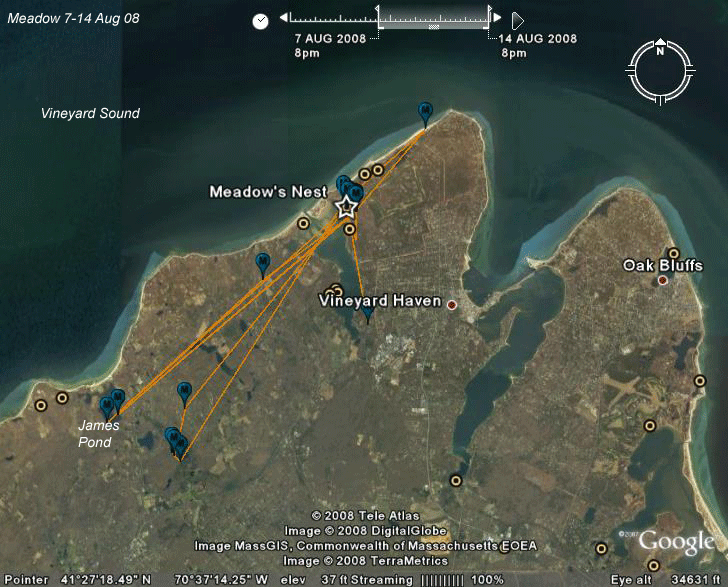 |
7-14 Aug 08. Meadow is beginning to explore. Like
Mittark, he has been trying out the baby pools--small freshwater ponds.
Both Meadow and Mittark (from the Lobsterville nest) have been to James Pond.
|
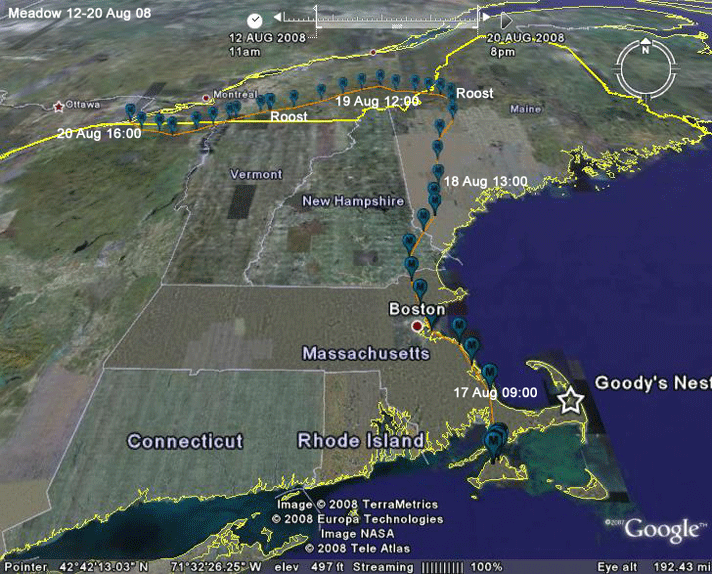 |
17-20 Aug 08.
There seems to be no end of shocking surprises with these young Ospreys!
Meadow left the Vineyard on the 17th and three days later settled down
in the middle of the St. Lawrence River in Canada. This trip was made
pretty much nonstop. Each point on the map is an hourly fix. He may
have done some fishing in the mornings prior to departing, but each day
at 10:00, when the GPS unit starts working, he was on the wing and
moving. This bird really, really needs a new compass!
We did have a young bird tagged in '04 leave its nest
and fly up to Portland, ME, when it took its first trip off the Island,
but that bird (Bunga) returned after a day or so and stayed around the
nest for another three weeks. Somehow I don't think Meadow is coming
back for a year and a half. But now that I've written that, he'll
probably come back just to prove me wrong again.
The whole trip was about 540 miles (860 km). |
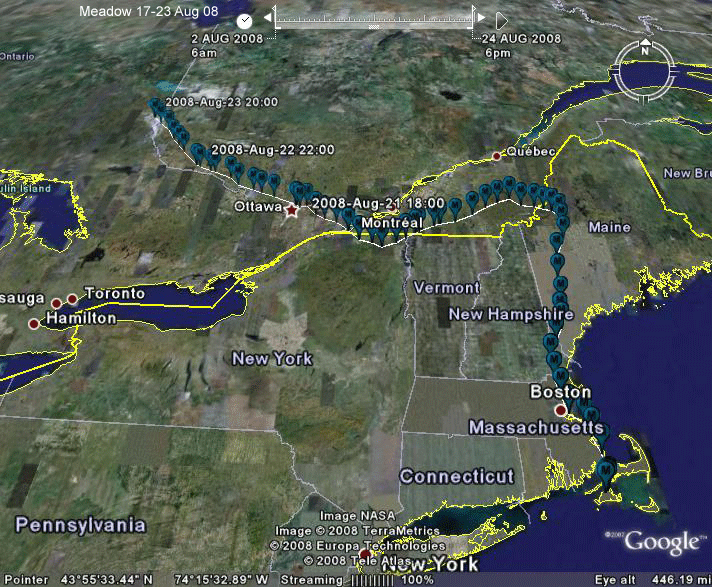 |
21-23 Aug 08.
Meadow flew another 317 miles (510 km) northwest in the past three days.
The blue patch at the top of the map is Hudson Bay! If he keeps this
up, he'll be eating salmon in the Yukon. He has crossed into the
Canadian province of Ontario. Whatever migration genes are driving this
behavior, they are unlikely to have much of a future in the gene pool.
It will be fascinating to see how this plays out. |
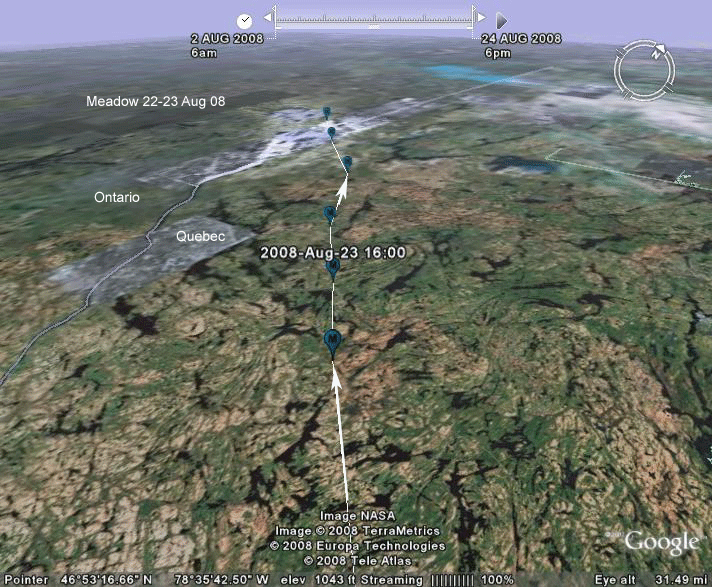 |
22-23 Aug 08.
Here's a close up of the amazing terrain Meadow is crossing in western Quebec
and eastern Ontario. There are certainly plenty of places to fish in
this terrain, but there is no long-term future for him in this direction with
winter coming on. |
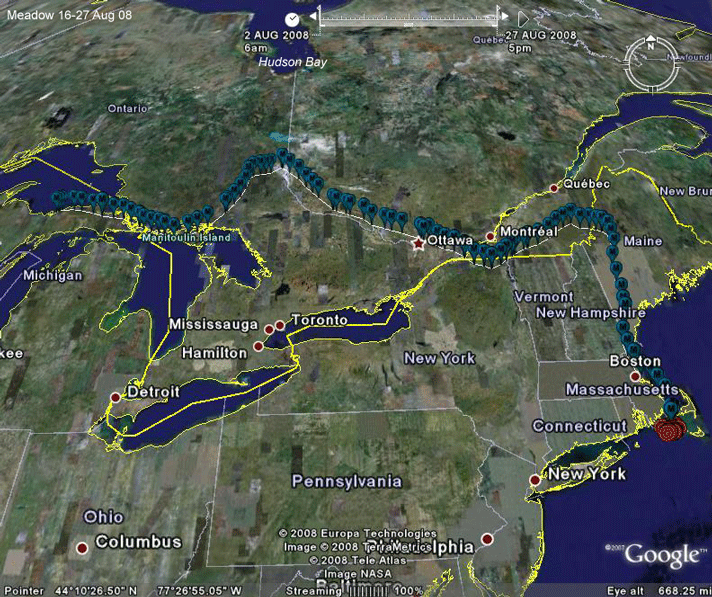 |
16-27 Aug 08. I
think Meadow needs to reboot his travel computer.
I was a little disappointed that he didn't go for broke and
make it to Hudson Bay, but I guess Lake Superior is shocking enough.
He clocked another 405 mi. (651 km) on the Ospreyometer
from the 24th-26th, bringing his total distance traveled in
11 days to 1,262 mi. (2,021 km). He would be in Florida by now if he
had taken the normal migration route.
Today's Geoquiz: name the Great Lakes. |
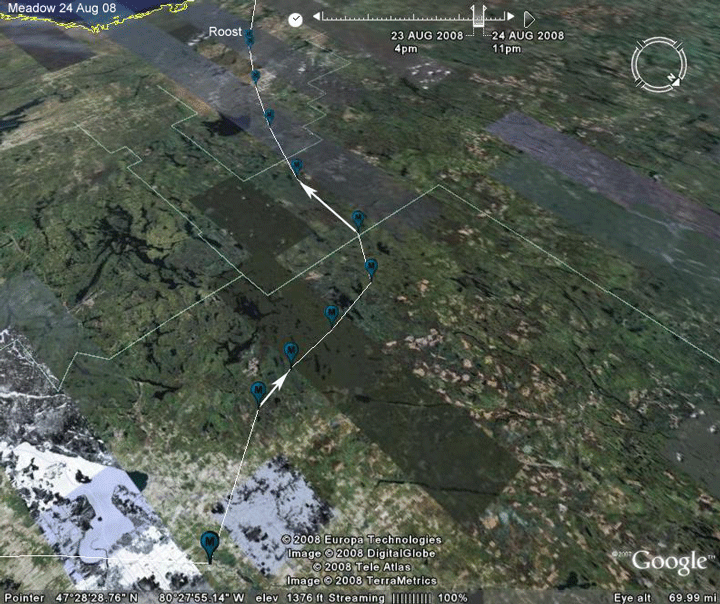 |
24 Aug 08. Meadow
has
turned south, but doesn't seem to have settled on a direction through
the 24th of August.
The topography here is fascinating. I'd like to have the canoe
distributorship around here. |
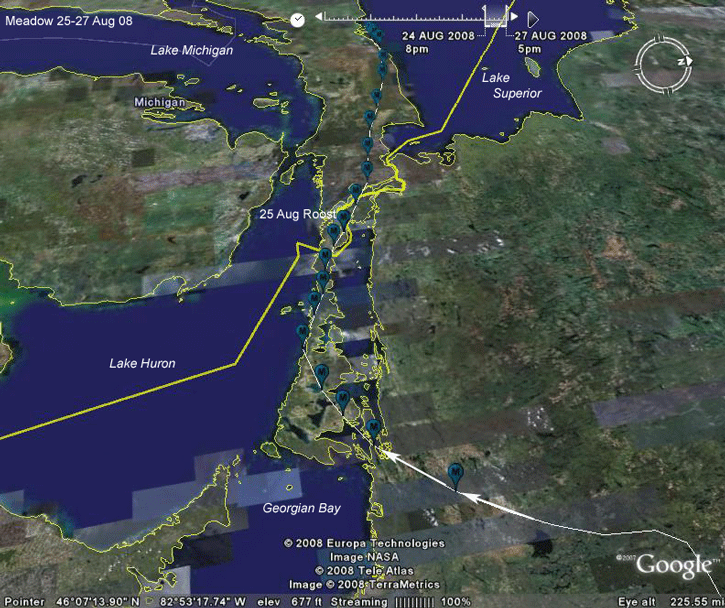 |
25-27 Aug 08.
Looking west in this view, we see that Meadow returned to the U.S. late
on the 25th, passing just west (above in this image) of Georgian Bay. On
the 26th he passed onto Michigan's Upper Peninsula and roosted on the
26th on Lake Superior's south shore. |
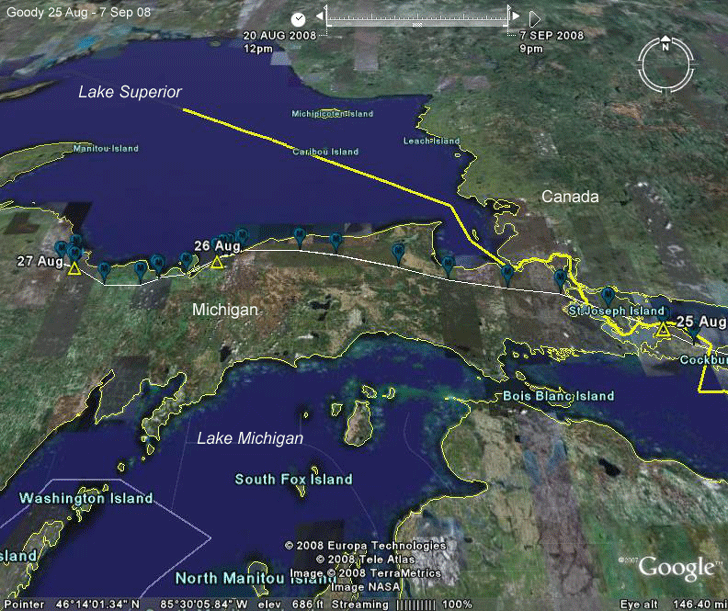 |
25 Aug - 7 Sep 08.
Looking north again, we see Meadow's track across Michigan's Upper
Peninsula. He found a small lake just a few miles south of Marquette on
the 27th and has been there since. |
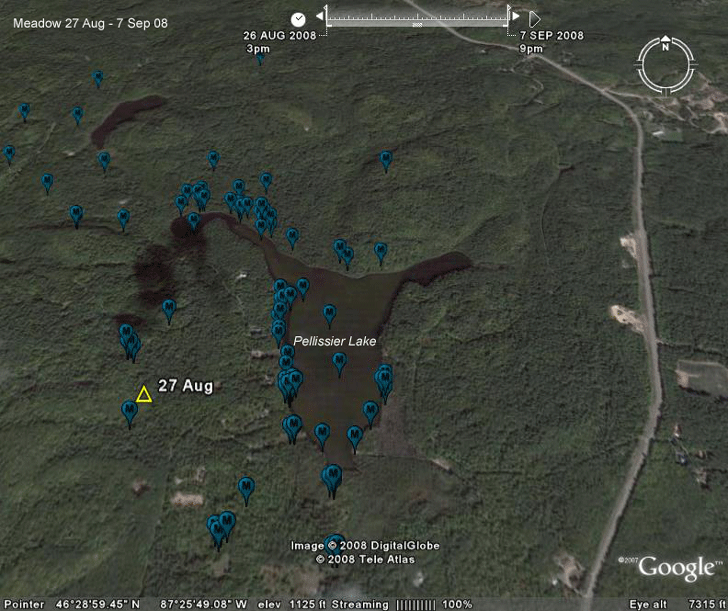 |
27 Aug - 7 Sep 08.
He's spent almost two weeks at this small lake. He's made a couple of
forays out to the north and west, but mostly he's been right here.
How long before he makes a move south?
Bonus question: What would a biologist familiar with human anatomy call
this lake? This may be a clue as to whether Meadow is male or female.
Maybe I have it wrong. |
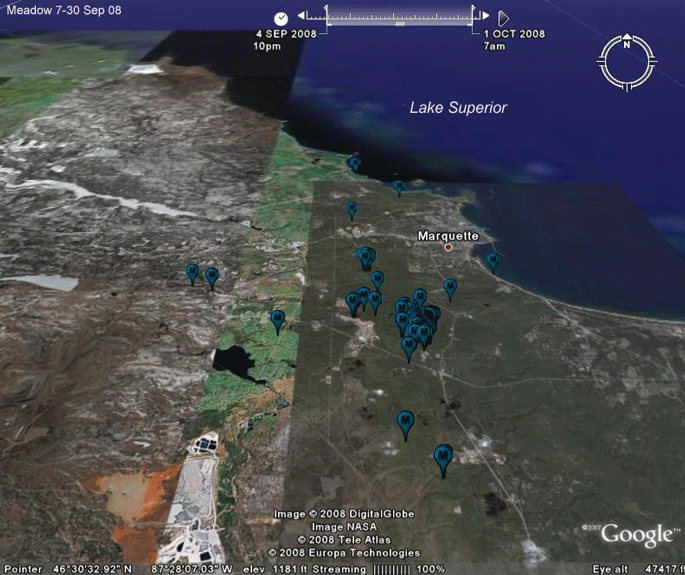 |
7-30 Sep 08.
Meadow has been exploring a bit around his base camp at Pellissier Lake.
He's made it up to the shore of Lake Superior three times. |
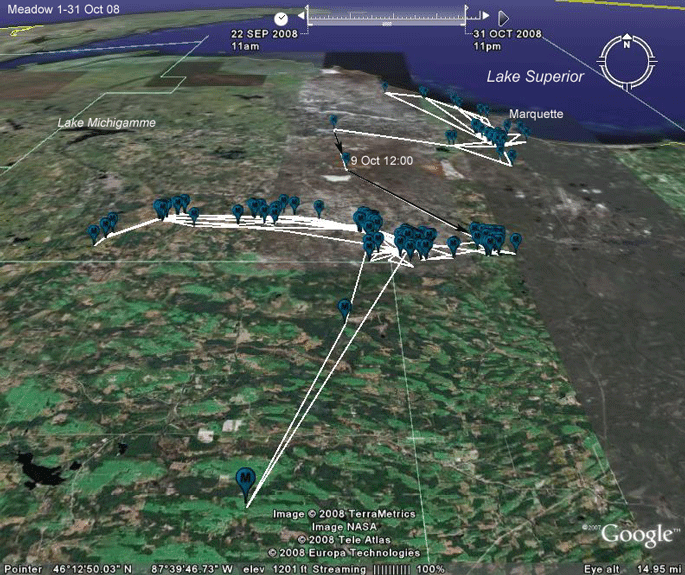 |
1-31 Oct 08.
Meadow continues to explore. This is exactly the behavior we see in
young Osprey that have arrived on their wintering grounds. It looks more
and more like Meadow thinks he should be settling down here.
He will soon be disabused of this notion. Winter may
come late, but come it will.
There was one move south on Oct 14, but he changed his
mind.
Mark Martell reports that Christmas Bird Counts in
Minnesota often include a few Ospreys. Meadow may wind up being one of
these odd records on someone's Christmas Bird Count in 2008. |
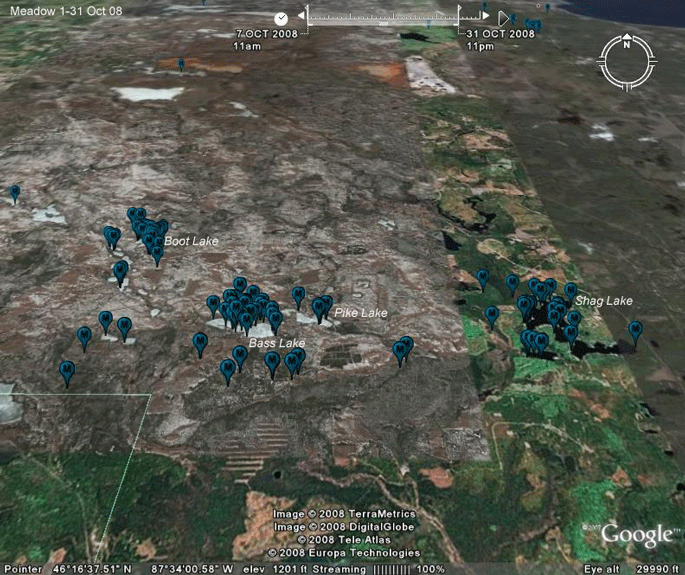 |
Oct 08. Here's a
close up of the lakes Meadow has been using for most of October. Pike
and Bass Lakes seem to be appropriate places for an Osprey to hang out.
'Shag' is 'cormorant' in Olde (British) English, so this is probably a good
place for fish-eating birds as well.
The photo that was used for the Bass Lake area was obviously taken
in the winter, when the lakes were frozen over. This is the landscape Meadow will be looking at soon enough if he doesn't move
south.
During this time he was moving back and forth across
this whole area. |
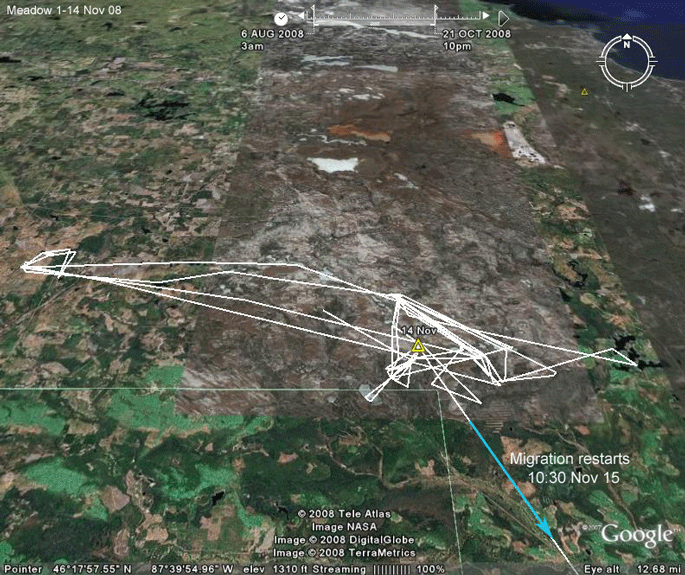 |
1-15 Nov 08. A
different view--just the paths between hourly fixes for the first two
weeks of November. He was fishing pretty much the same area we saw him
in throughout most of October although he spent less time around
Shag Lake.
Sometime after 10:00 on the 15th he rebooted the
migration computer and took off. This time he's headed in the proper
direction! |
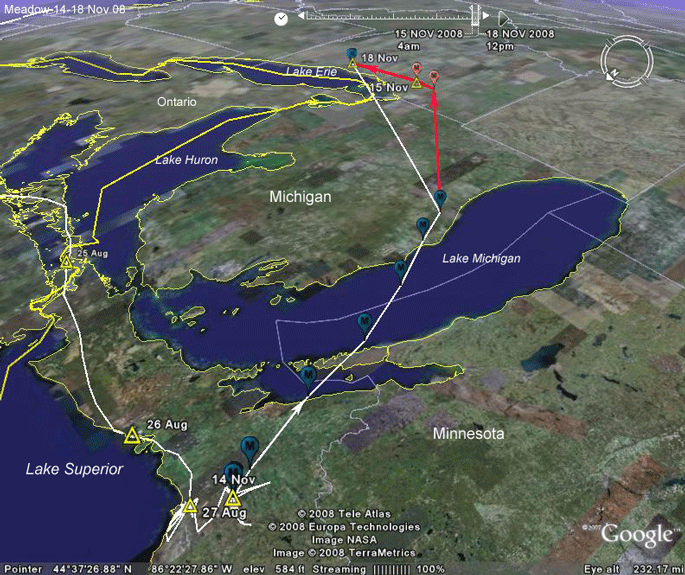 |
14-18 Nov 08 (Looking southeast
again)--Fired (?) up by a week of sub-freezing
nights and a bunch of snow, Meadow blasted out of Michigan's Upper
Peninsula sometime after 10:00 on the 15th. He covered an amazing 175
mi (281 km) in the first four hours, averaging 44 miles/hour (72 kph).
That's a new record. He was up at 1500 ft (500 m) as he crossed Lake Michigan.
Our last GPS fix on the 15th was at 16:00. The next GPS
fix was just northwest of Akron, OH. The red path and pink point
locations are non-GPS points calculated during the satellite upload
Meadow's data after the GPS unit had shut down for the day. These are
'bonus' locations--they're not as accurate as the GPS fixes, but they do
tell us that his real path was
south of the line connecting the last GPS fix of the 15th and the 1st on
the 16th.
We also know that he kept flying through the
night--first time we've seen a tagged bird do this over land. We don't know where he finally settled down for
what was left of the night, but it was probably all the way to his
current location south of Cleveland.
If so, he covered 510 mi (820 km) on this leg of his
resuscitated migration. |
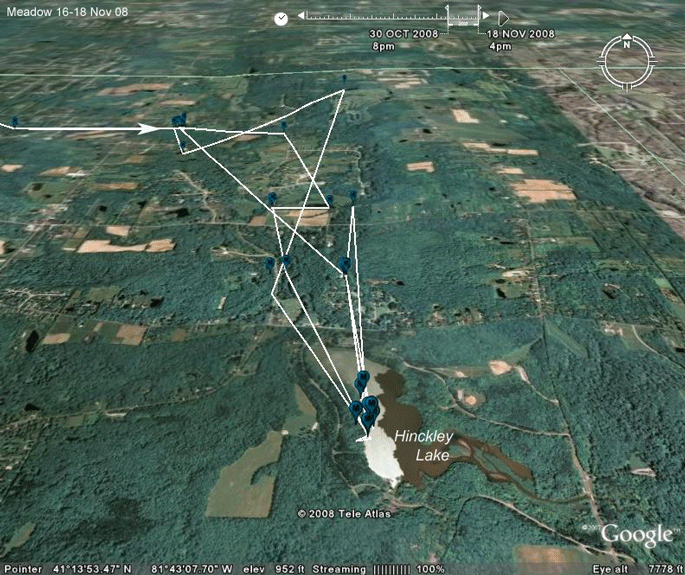 |
16-18 Nov 08
(Looking north)
Meadow has been looking for fish in Hinckley Lake (18
mi/30 km) south of Cleveland, Ohio.
The landscape right now most definitely does not look
like what's pictured here. Switch the green for white and you probably
have a much better feel for current local conditions. |
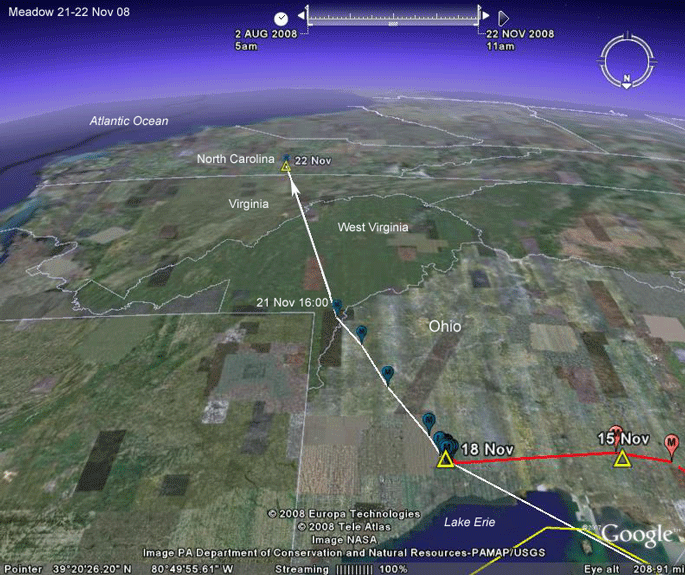 |
21 Nov 08
(Looking south)
Meadow decided that he had had enough of this snow stuff. By 13:00 on
the 21st he was on the wing, heading southeast. He covered 97 mi
(156 km) in 3 hours. Once again, he had tailwinds thanks to a big
high pressure system over Tennessee.
His GPS unit shut down for the day as he headed into
West Virginia, so we don't know how far he got that night, but suspect
he made it all the way down to Greensboro, NC, where we got his first
location on the 22nd. At 32 mph (his speed for the first 3 hours) it
would have taken him another 8 hours to get there, meaning a midnight
arrival in Greensboro.
Alternatively, he might have roosted somewhere along
the way and then moved a bit further south in the morning. When we next
heard from him, he was on the shores of Lake Townsend, about 5 mi north
of Greensboro, NC. |
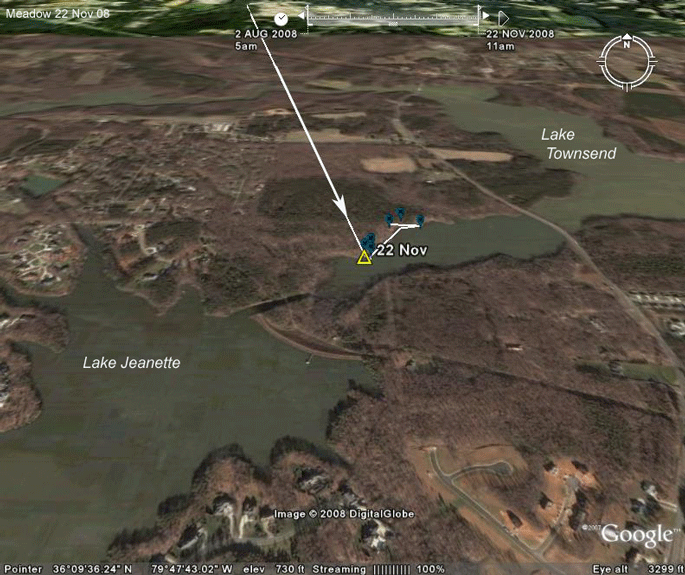 |
21-22 Nov 08
(Looking north)
Looks like Meadow is stopping to refuel with some fish from Lake
Townsend.
He's got lots of options for fishing here. He's in
the middle of a long series of reservoirs on tributaries of the Haw River, near
Greensboro.
His 2,192 miles (3,528 km) of travel have gotten him to
a spot about 600 miles (as the crow flies--or the Osprey should have
flown!) from his nest. He'd probably be in Cuba now, had his flight path
agreed with the one that should have been laid down in his genes.
Another day's migration will get him to the SC coast,
which is only about 180 mi (290 km) south. The weather for the next few
days doesn't look like it will be conducive to migration, so he may be
in the Greensboro area for a while. The good news is that he's not going
to find all his potential fishing holes frozen over. |
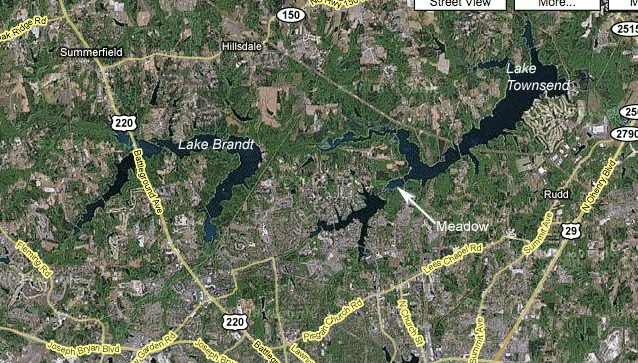 |
21-22 Nov 08
Here's another view of the system of
reservoirs north of Greensboro, NC, where Meadow is in temporary
residence. |
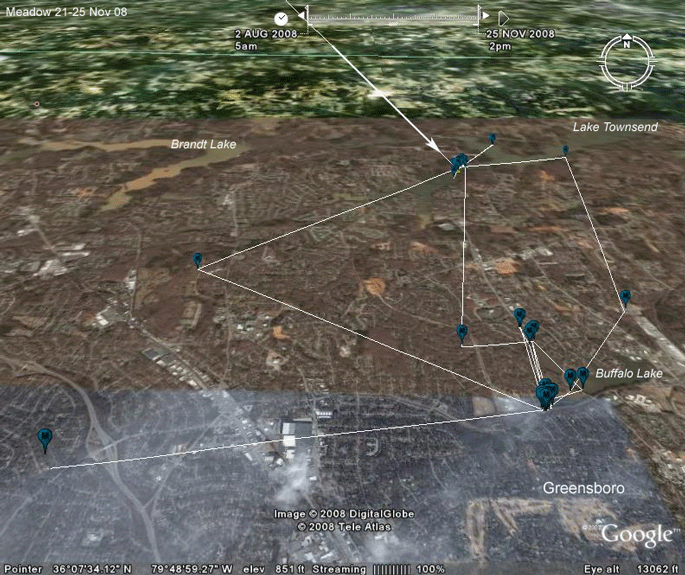 |
21-25 Nov 08
(Looking north)
Weather hasn't been very good for migrating, so Meadow is exploring
Greensboro, pretty close to downtown at Buffalo Lake.
Of course we're now speculating on where Meadow
will settle down for the winter. Our latest bird ever (Homer in 2005)
had a first migration not dissimilar from Meadow's, although without
such a dramatic detour.
Homer got to NC in September and then turned around and
flew north into Virginia, where he settled down until late October, when
he finally turned on the migration engines again. He stayed in the
Everglades for a while, and finally crossed the Caribbean in late
November. |
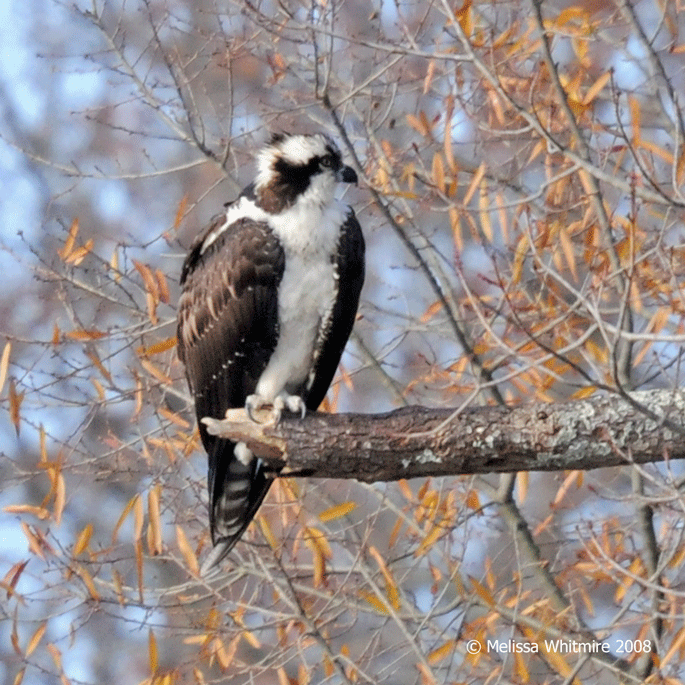 |
26 Nov - 5 Dec 08
Meadow settled down around Buffalo Lake for a week or
so. I emailed the local Audubon chapter in the hopes that someone would
spot him. On such a small lake with access all around, it seemed like a
pretty sure thing. Sure enough, I got an email from Melissa Whitmire
with a photo of Meadow on the 4th, so I headed up the road to Greensboro
on the 5th, hoping to see for the first time one of my tagged birds in
the flesh after it had left its natal territory.
From Melissa Whitmire's journal:
On Friday, December
5th, I had the good fortune to
be one of the rare individuals who has seen, and photographed, one of
Robís Ospreys after it had left the breeding grounds. According to his
GPS data, Meadow had toured Greensboroís
extensive reservoir system for several days but true to his
Marthaís Vineyard upbringing, had taken up his brief
residence on a private lake in one of our upscale neighborhoods. After
knocking on several doors, I found an enthusiastic, retired couple who
allowed me to camp out in their yard down by the water, a spot with
perfect views of this extraordinary bird. I had the honor of sitting
with him for nearly two hours while waiting for Rob to arrive from
Charlotte. |
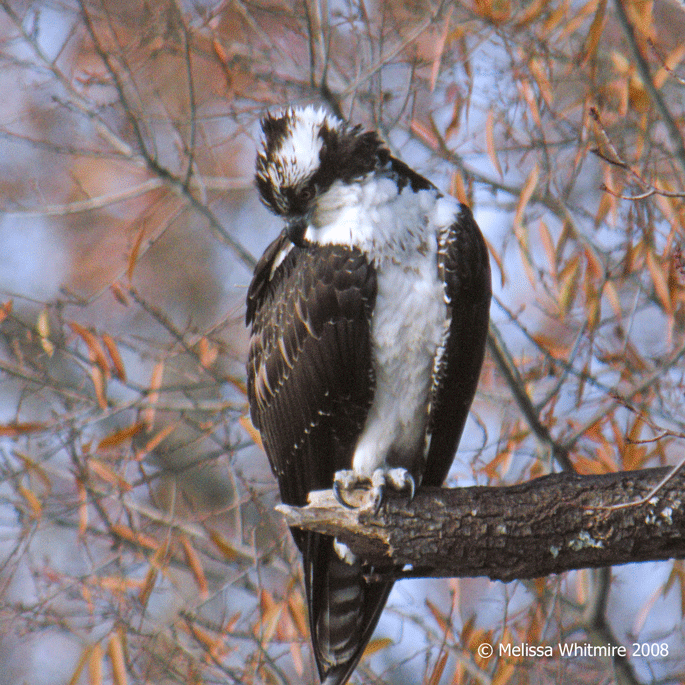 |
I canít say that Meadow exhibited any
earth-shattering behavior during that time, but what a thrill it was for
me to watch a bird that only months earlier, and 600 (or should I say
2,192?) miles away, had been in Robís hand. Perched on a dead branch
that was overhanging the water, he basically did three things: preen,
snooze, and watch the goings-on around him. He mostly kept an eye on the
water under his perch- I suppose looking at fish that were swimming just
beneath the surface. He routinely checked on me and the workers that
were repairing a foot bridge about 75 yards away but otherwise was
fairly indifferent to our presence.
While pondering the history of this young and
unpredictable bird, I marveled at the beauty of his feathers; they
seemed so bright and crisp. The shades of brown were deep and rich and
stood in stark contrast to the white on his belly and head.
I laughed whenever heíd see something particularly interesting
because heíd raise his head feathers and would look just like the
picture on the Migration í08 page.
|
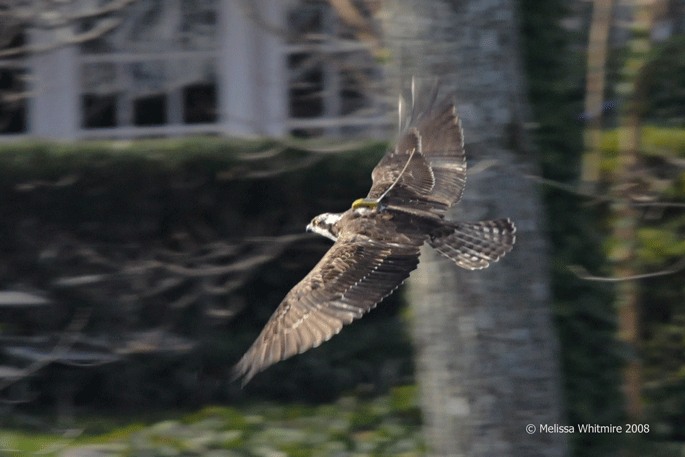 |
Every so often heíd tuck his head in for a
snooze so I didnít worry about him taking flight before Rob arrived. I
got complacent though and he caught me off guard. A small flock of
Canada Geese had flown in and were serenely paddling around in the cove
behind him. Nothing had bothered him up until this point; not the
workers on the bridge nor the people walking on the foot path nearby.
However, when the geese swam underneath his perch he looked down at them
and in the blink of his fiery Osprey eye, took off. I grabbed the camera
and got some shaky shots of him flying down the lake. I thought he might
be going to the perch on the east end where we had seen him the day
before but I was wrong. He started flapping hard, circling higher and
higher and before I knew it, he was gone.
With a sick
feeling in my stomach I called Rob and told him that Meadow had flown
the coop. He arrived only five minutes later. We hung out for several
hours, periodically riding around and scoping the four sections of
Buffalo
Lake where he
had his highest clusters of GPS points, but we knew he was gone. It was
a beautiful day with winds out of the northwest, perfect conditions for
a flight southeast to the coast. Rob says Meadow left because he knew
Rob was getting close. I canít argue with that logic!
|
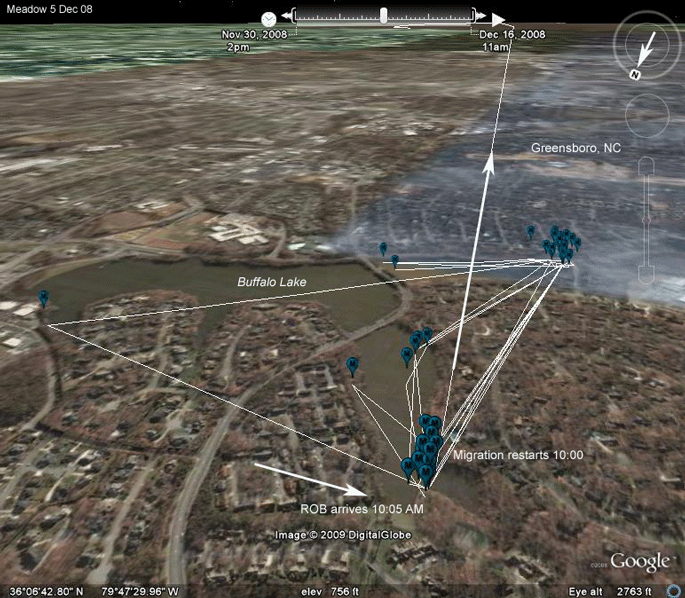 |
Back to maps!
We're looking south here at Meadow's favorite perches
around Buffalo Lake.
The larger white arrow indicates his escape
route as I approached from the east (the smaller white arrow).
|
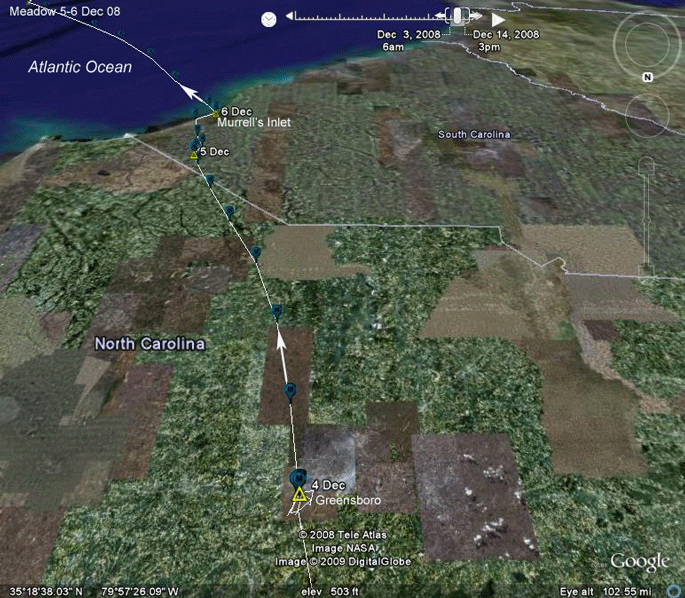 |
5-6 Dec 08
(Looking south)
Meadow made it to South Carolina on the 5th. He spent the night in
a swamp just across the NC/SC border near Conway, SC, and then moved
just 42 miles (68 km) further south before roosting near Murrell's
inlet. |
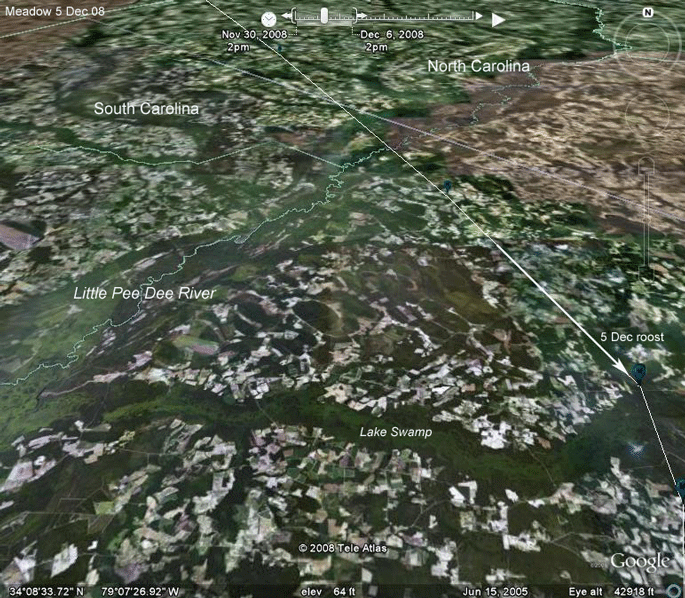 |
5 Dec 08
(Looking north)
Meadow spent the night in Mitchell Swamp, which feeds into Lake
Swamp (make up your mind!), which feeds into the Little Pee Dee River as
it meanders through the South Carolina low country, heading to
Winyah Bay near Georgetown, S.C.
(Anyone want to diagram that sentence?)
Meadow covered 146 miles (235 km) on the 5th, averaging
about 25 mph along the way. |
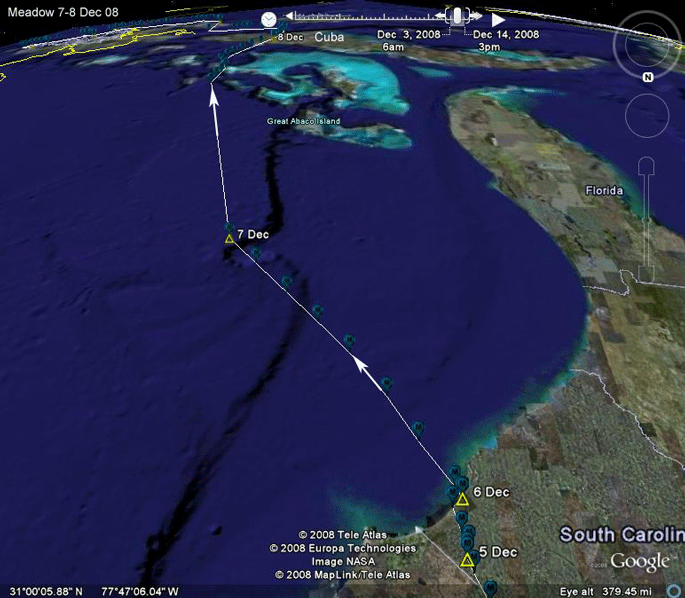 |
6-7 Dec 08
(Looking south)
Meadow moseyed a mere 42 miles (68 km) down to
the coast on the 6th. At 09:00 on the 7th Meadow was 6 miles out over the Atlantic, heading,
unbeknownst to him, for Hispaniola in the eastern Caribbean. A
mid-course change in his heading brought him to the Bahamas. His GPS unit was on for 7 hours,
shutting down at 16:00. At that point he had covered 317 miles (510 km)
in 7 hours, averaging a remarkable 44 mph (73 kph), almost twice his
speed on the Greensboro to South Carolina leg.
When his transmitter came back on at 06:00 on the 8th,
he had covered another 380 miles (610 km) in 14 hours, averaging only 28
mph (44 kph), so he must have lost the tailwinds he enjoyed as he left
the S.C. coast. |
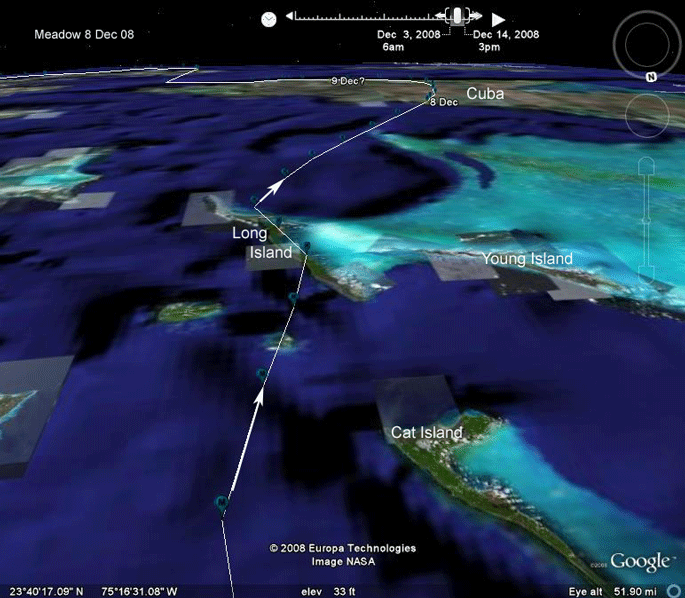 |
8 Dec 08
(Looking south)
About 22 hours later, on the morning of the 8th, Meadow arrived
over a small island in the Bahamas, between Cat and Long Islands. If he
stopped to rest, it wasn't for long. He flew over Long Island, again
there's no evidence that he stopped for anything but a very brief rest.
At 16:00 he was 35 miles (56 km) from Cuba's north
shore. He spent the night there before continuing his migration.
The Ospreyometer, set to zero when he left Martha's
Vineyard, now reads 3,318 miles (5,349 km).
|
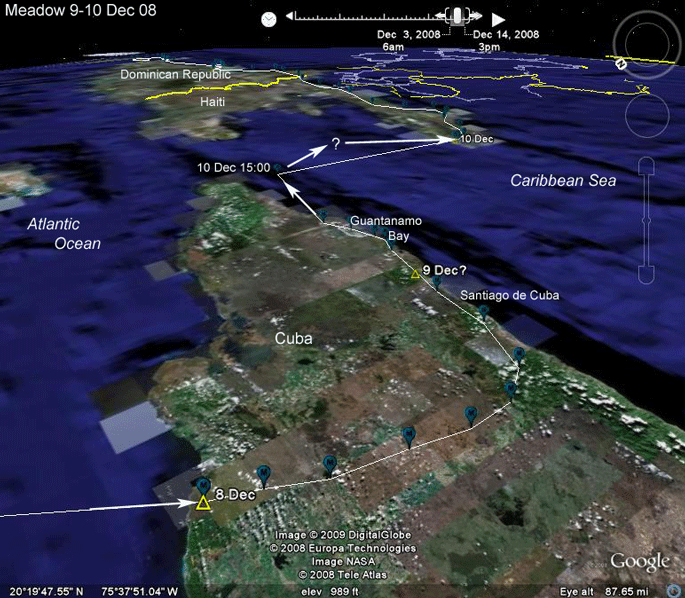 |
9-10 Dec 08
(Looking southeast)
Another day's flight brought Meadow to the south shore
of Cuba. We're not sure where he roosted (hence the question mark after
the date), but it was somewhere between Santiago and Guantanamo Bay.
When we order the satellite transmitters (PTTs), we set their "duty
cycles"--the time they turn on and off each day. For the migration
period the PTTs are on from 10:00 to 20:00. This usually covers the time
of day when our birds migrate over land. For the non-migration period,
we shift the duty cycle to 06:00 to 16:00, so we can see what they do
early in the day on the wintering grounds. Because Meadow is migrating
after the normal migration period, his PTT is in
the winter duty cycle. This is why we're not getting data from the end
of his travels each day, and hence don't know exactly where he roosted.
On the 10th he was on the move again, out over the
Caribbean at 15:00, when we got our last signal for the day from his
transmitter. We don't know his exact route, but somewhere in there he
turned south and spent the night on the southwestern tip of Hispaniola,
in Haiti. |
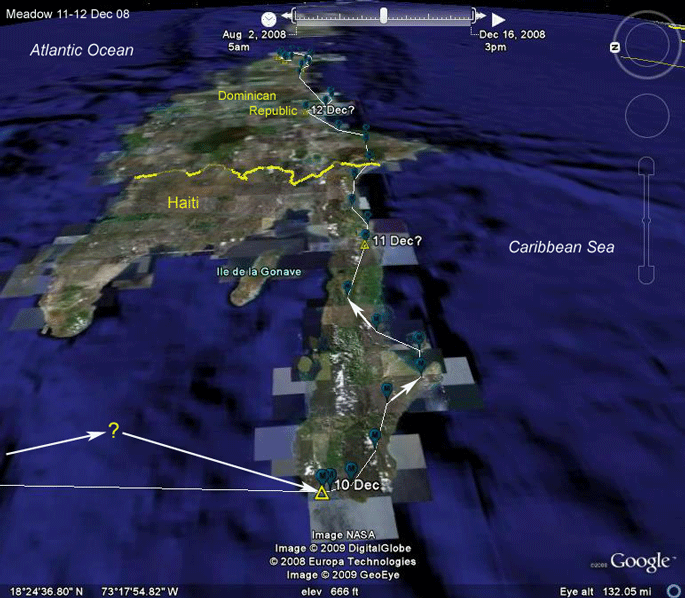 |
10-12 Dec 08
(Looking due east)
Meadow hugged the southern coast of Hispaniola, crossing into the
Dominican Republic on the 12th. |
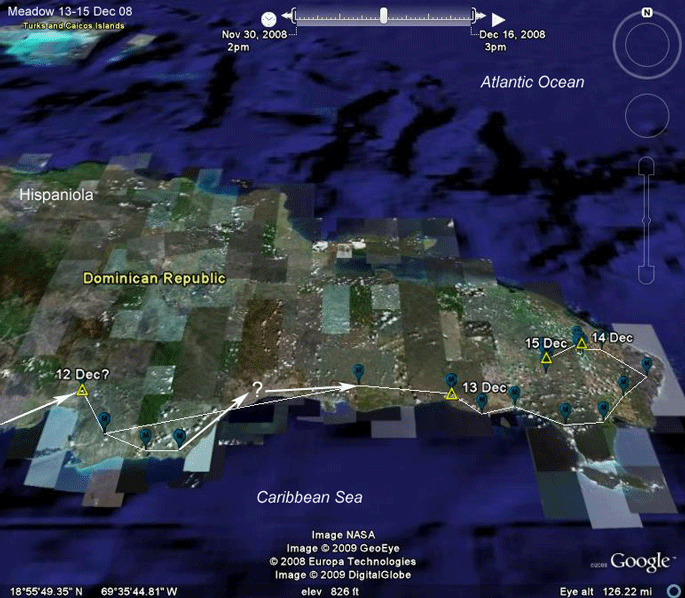 |
12-15 Dec 08
(Looking north)
Meadow continued across the south coast, probably passing right
over Santo Domingo (where two of our other birds have been shot). On the
14th, he was still in the mood to move, but ran out of island, so he
bounced back to the west. He moved a few more miles west on the 15th and
now seems to have settled down.
Since he left Martha's Vineyard on 17 August, he has
migrated 4,137 miles (6,658 km). During the 121 days between leaving the
Vineyard and apparently settling down here, he was actually migrating
only 24 days, averaging 172 miles (277 km) per day, which is fairly
typical. What is definitely not typical is to have that migration
stretched out over 121 days.
An experienced adult would have covered about 2,400
miles (3,800 km) to get to this point. Ah, youth!
|
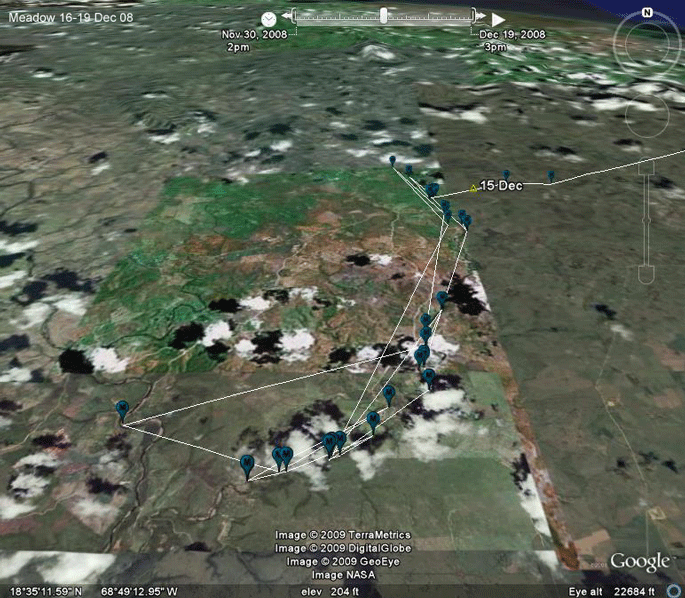 |
15-25 Dec 08
(Looking north)
Meadow definitely seems to have flipped the migration
switch to the off position. Given our 0 for 3 survival rate of Ospreys
trying to overwinter in the Dominican Republic, we are concerned. The
good news is that he has settled down in a very sparsely populated
region, although he is only about 6 miles from the town of Higuey. He is fishing up and down a small river that flows through an
agricultural landscape.
We'd love to see him kick into migration mode again and
make it to South America, but I don't think he will. But then, nothing
I've predicted about this bird has actually taken place. |
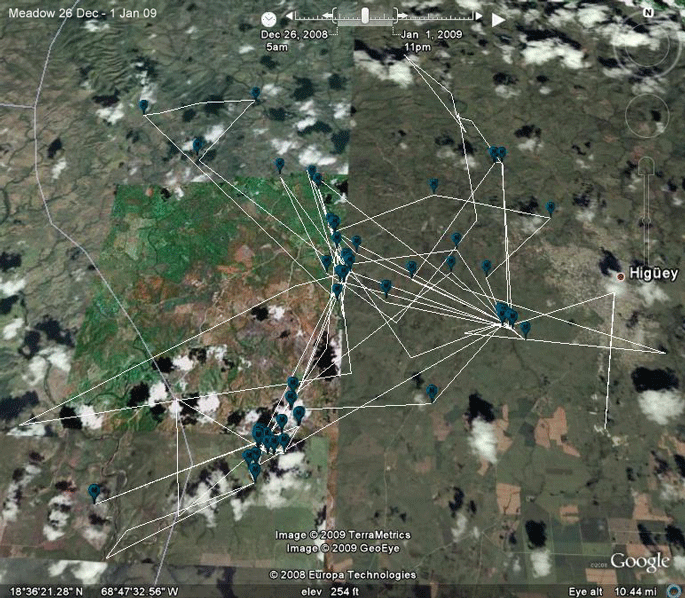 |
26 Dec 08 - 1 Jan 09
(Looking north)
The one prediction about Meadow that I wanted to be
wrong wasn't. He apparently wasn't finding enough fish in that little
river, so he continued exploring, but migration is over.
Unfortunately, he found a pond on a farm just a couple
of kilometers west of Higuey, which he returned to from day to day. |
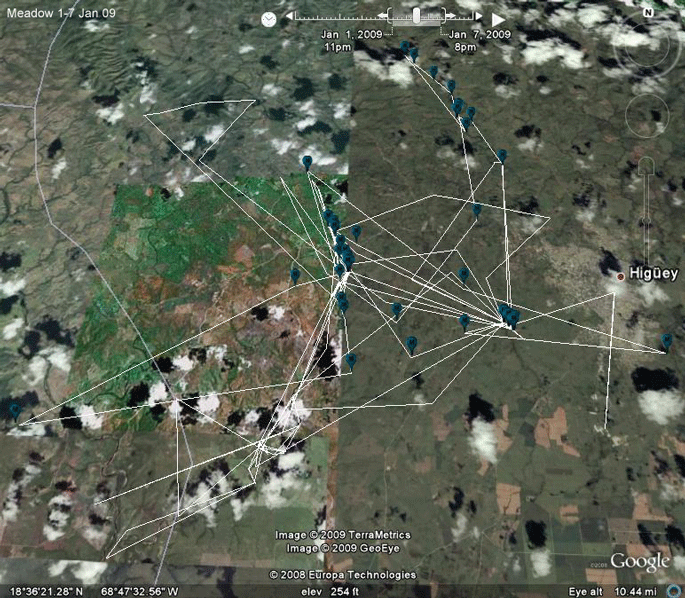 |
1-7 Jan 09
(Looking north)
Meadow continued to wander around this area, but kept
coming back to the farm pond, where he was apparently shot on the 7th. |
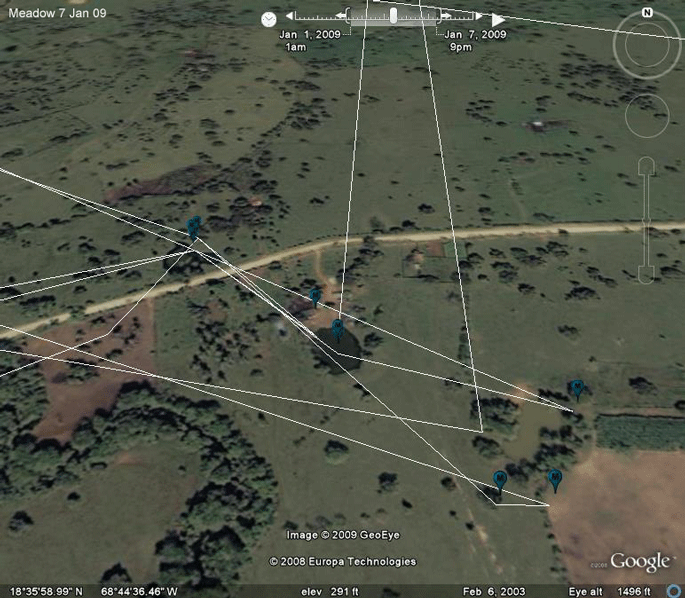 |
7 Jan 09
(Looking north)
Meadow's last location was over the pond on this farm
just on the outskirts of Higuey, in the eastern Dominican Republic.
We can only assume that the farm owners or someone on
their staff didn't want to share the fish in the pond with our bird.
This makes the fourth bird out of four that ended their
migrations in the D.R. that we have lost. In two cases, we know that the
birds were shot, as someone has called me after reading my phone number
on the transmitter.
The third bird lost, Mittark, was probably shot, and
this bird, Meadow, almost certainly was, as a bit of long-distance,
satellite telemetry-based detective work (see below) suggests.
Losing four out of four birds certainly suggests that a
lot of Ospreys are being shot in the D.R. The good news for Ospreys is
that most of them don't stop in this black hole, but continue on to
South America, where they spread out over a vast area, most of which is
unpopulated. Another plus for Ospreys is their site fidelity. Once they
find a wintering spot, they stay put, and often the area they range over
is very small, minimizing the chance that they will wander into danger. |
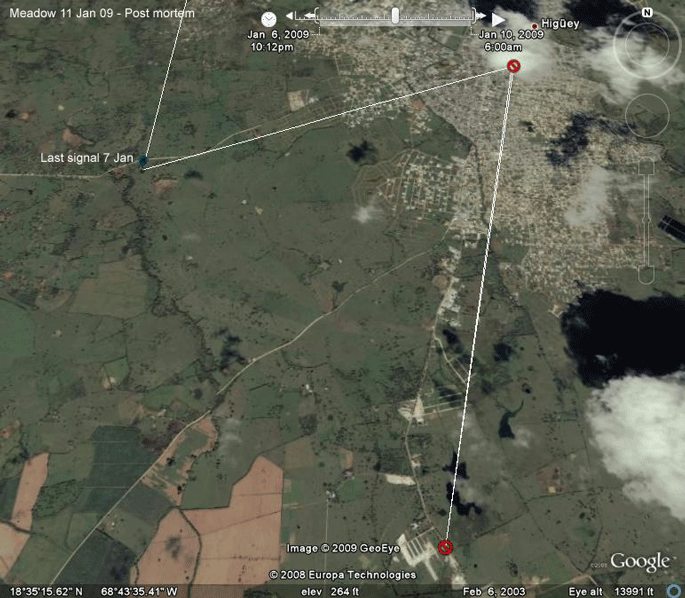 |
7-11 Jan 09
After the signal on the pond on the 7th, there were no
signals from Meadow's transmitter until the 10th, when we got a series
of locations in the middle of the city. Then we got one south of town,
after which the transmitter returned to the city.
We have deduced that someone from the farm lives
in the city and had the transmitter in their car. The location south of
town looks like some sort of feedlot, so whoever has the transmitter
went down there, perhaps on farm business, on the morning of the 10th
and then returned to their home. (Big Brother is indeed watching!)
One of the goals of our research is to understand where
mortality occurs in juvenile Ospreys. The loss of these four birds has
given us some insight into the problem here. (More on this below)
|
The
first bird we lost, Moshup, was shot by hunters who mistook him for a Red-tailed
Hawk. Red-tails, which do take chickens once in a while, are very unwelcomed in
the rural countryside. Chickens are an important food source from much of the
rural population and cock fighting is a deeply entrenched part of the local
culture, so any predator seen as a threat to chickens has few friends out in the
countryside. The hunters who shot Moshup realized their mistake and tried to
save him, as veterans on this site will remember. If they'd only been better at
raptor identification!
Luke was shot early in 2008 at a large lake where,
according Luiz Vallez, who recovered the transmitter, "they shoot everything."
Luiz was really distraught. He didn't want the reward, he just wanted to know
what could be done to stop the shooting!
Since we launched the "Rescue Moshup" effort back in
'06, I have been in contact with Jorge Luiz Brocca, the president of the
Hispaniola Ornithological Society. Jorge is very concerned about this high
mortality we have documented and will help us with an educational campaign.
We have a pledge of support from the
International Osprey Foundation and will
work with Jorge to do what we can in the arena of public education. There's
probably not a lot we can do, but we'll try. Many of the citizens of the D.R.
likely to shoot an Osprey have no access to television or newspapers, so we
really can't reach them. We can and will use the popular media to spread the
message that Ospreys eat fish and not chickens. Perhaps education about the
remarkable migration these birds make will keep a few fingers off of triggers as
well.
Birds
of Prey page -- Osprey
main page -- Migration
page -- Home
Page
|




































